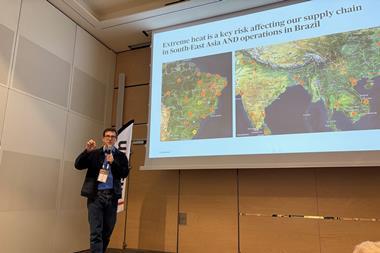ISIS Asset Management, one of the City's largest institutional investors with £63.8bn of funds under management1, recently published a report entitled Are Extractive Companies Compatible with Biodiversity?.
This benchmarked 20 global extractive (oil, gas and mining) companies, and provided a snapshot of how a high impact sector is managing the issue of biodiversity at the levels of policy, implementation and reporting.
As considerable work had already been done elsewhere2 on defining biodiversity and explaining why it represents a risk to the extractive sectors, ISIS's approach was to analyse the response of companies to the challenge of biodiversity management, from the perspective of an investor. It answers a simple question: how well are companies doing?
The data, gathered entirely from published sources, reveal wide disparities between companies, and identify three broad categories of performance:
- Six companies were the race leaders
- Seven companies were in the chasing pack
- Seven companies were on the starting line.
In the leading group were Anglo American, BG Group, BP, Rio Tinto, Shell and Statoil. ChevronTexaco and Brazilian mining company CVRD were close behind. European and US majors Total, Repsol and ExxonMobil fared relatively poorly, while emerging markets companies - essentially Russian and Chinese companies - were in general the weakest performers.
Investors and biodiversity
Biodiversity is sometimes described as 'the next climate change'. It is an issue of global importance, which is difficult to measure and whose relationship with the corporate sector is little understood. However, it has the potential to become rapidly and significantly material if the governing convention's principles (the 1992 Convention on Biological Diversity3 or CBD) start to be implemented rigorously. Ten years ago, climate change was not seen as material. Today, few investors fail to consider it when valuing companies in sectors with an exposure to climate change. Biodiversity is beginning to enter the consciousness of investors as an issue of equal, and potentially greater, significance.
Why the extractive industries?
Extractive industries are particularly vulnerable to the issue of biodiversity for five reasons:
- They cannot dictate where reserves are located, and so may often find themselves operating in delicate ecosystems; importantly, it also means that mismanagement of biodiversity by others may have a knock-on impact on a company's own operations.
- Extractive industries' basic operations are likely to have a negative impact on biodiversity.
- If extractive companies mismanage their basic operations - for example, through oil spills - they can cause damage on a vast scale.
- There is a widespread public debate, and potential for legislation, on the issues of access to protected areas and liability for damaging biodiversity. Such legislation would instantly change the risk profile for companies with biodiversity-related liabilities.
- The extractive industries, in part due to past environmental errors, have engendered profound mistrust among NGOs. This difficult relationship is significant, since NGOs are a powerful voice in public debates on biodiversity and related issues.
To illustrate the above points, a recent report from the World Resources Institute (WRI) notes that 'three quarters of active mines and exploratory sites overlap with areas of high conservation value and areas of high watershed stress.'4
Complex biodiversity management
Biodiversity management is complex. Still more so is the question of what companies should do about it, and where their responsibility starts and ends. There are likely to be issues which are different to those which companies are familiar with through their standard environmental management system (EMS) processes.
Such issues include examining impacts over a wide geographical area - the so-called secondary impacts; dealing with impacts which are known to take place, but cannot be measured or wholly attributed to the company; and the dependence of other stakeholders on biological resources for their livelihoods. A particularly complex issue can be the designation of land as being of biodiversity importance by groups which are far removed from the physical location of a particular project, sometimes in contradiction to the legal designation by a local government.
These and other complexities means that there is currently no standard way of managing biodiversity within the traditional management systems approach, so individual companies are left to define and manage the problem as they see fit.
Key survey findings
The survey's key statistical findings were as follows:
- 65% of companies surveyed do not have a published policy or position statement on biodiversity
- 50% showed no evidence that an approach to biodiversity is applied on a company-wide basis
- 40% do not provide evidence that biodiversity is integrated into their environmental management systems or procedures
- 65% do not have reportable targets
- 35% of companies scored zero in the survey5.
Considerations for investors and companies
The report also identified a series of considerations for extractive companies in relation to biodiversity, including the issues of ecosystem management, reporting and transparency. In particular, it noted the need for a ecosystem approach and recognition of the two-way relationship with biodiversity risks, arising as a result of:
- The impact which a company might have on biodiversity through its own activities
- The impact which mismanagement of biodiversity by others may have on the company.
This means that companies need to have an understanding of the complex dynamics of biodiversity, both ecological and political, and how these may affect their businesses. They then need to devise a management approach which takes into account the wider view of the company's activities, influence and impacts in relation to biodiversity. This approach is likely to include managing the direct impacts of the business operations within the ecosystems in which the company is operating, as well as the indirect or 'secondary' impacts.
However, a risk-based management approach is also likely to need to address the impact which mismanagement of biodiversity by others may have on the company, particularly at the ecosystem level. For example, the small area of forest directly affected by mining operations may become of heightened interest to the world conservation community if the rest of the forest becomes damaged through poor control of illegal logging activity by a government. In other words, when approaching biodiversity management, companies need to consider and understand the ecosystem of which they are a part, and manage their operations accordingly.
On reporting, it was notable that 65% of companies in the survey did not have reportable targets for biodiversity. At the upper end, this often distinguished the good companies from the very good. Although biodiversity management, and therefore measurement and reporting, are in their infancy, the setting and reporting of targets should be as integral to biodiversity as to other aspects of management. Furthermore, some companies' current biodiversity reporting and targets are of a poor standard. Across the sector, there is a need for greater rigour and consistency.
What are the key risks?
The report found that there were two key areas of biodiversity-related risk for extractive companies.
First, the debate over access to protected areas is becoming lively.
It is therefore good risk management for companies to identify and report on areas where their activities affect protected areas. Since companies are likely to be challenged on this issue, it is also appropriate to have in place a policy or corporate position on protected areas.
Perhaps the most significant material risk for companies is the issue of biodiversity liability. Extractive companies have the potential to do great damage over the long-term, affecting many other interest groups in the process. Ecosystem services supported by biodiversity have been very approximately valued at US$33trn per year, or approximately twice the global GNP6. If companies were legally liable for damage to biodiversity, this would constitute a significant material risk. There are early signs that regulators are examining this approach. For example, the draft EU liabilities directive contains references to biodiversity liabilities.7
Investors' concerns
The report noted five areas of concern for ISIS as an investor, which will be equally applicable to other institutional investors. The concerns were:
- Biodiversity is an area of risk for extractive companies; in certain areas and circumstances, this risk is significant and material.
- In particular, there are risks relating to protected areas, liability, and the mismanagement of biodiversity by others.
- While certain companies are well-equipped to understand these risks and start to manage them, others are apparently ignoring them.
- Industry bodies have played an important role to date; however, poor performance by a few companies could make the entire sector subject to public pressure or legislation.
- Even the best companies are only at the start of the process of moving policy into performance, measurement and reporting.
Summary of recommendations
ISIS concluded the report by issuing four recommendations, which will form the basis of its shareholder engagement on biodiversity:
1 POLICY: companies should have a specific statement on biodiversity; this statement should explicitly state the company's position on protected areas.
2 MANAGEMENT: companies should integrate biodiversity within their environmental management systems but at the same time should publish information about the specific biodiversity risks which are relevant to their business and how these are being managed.
3 REPORTING: companies should identify their progress on biodiversity within their public reporting, and support this through reporting progress against targets.
4 LONG-TERM RISKS: companies should work with industry-wide initiatives on biodiversity to identify and mitigate long-term risks for the sector; in particular, companies should assess and report on their exposure to protected areas including IUCN categories 1-IV.
These considerations, both for extractive companies and other sectors, will be given added impetus by the implementation of the OFR in the UK.
A company's OFR will need to include information on environmental matters where the directors judge this is 'necessary' to enable shareholders 'to assess the strategies adopted by the company and the potential for those strategies to succeed'. The Government's consultation document gives examples of issues that companies might have to cover. These include 'management of biodiversity issues where failure to avoid or mitigate damage would put development consent at risk'. Biodiversity is likely to be a risk for a range of sectors, and companies will soon be required to identify the precise nature of the risks and report on them.
1) As at 30/3/04
2) e.g: Integrating Biodiversity Conservation into Oil & Gas Development (Energy & Biodiversity Initiative (EBI), Washington, 2003]; Business & Biodiversity: A Handbook for Corporate Action (WBCSD, Geneva, 2002).
3) See www.biodiv.org
4) Mining and Critical Ecosystems: Mapping the Risks (World Resources Institute, Washington, 2003]
5) i.e. they gave negative answers to all questions asked.
6) The value of the world 's ecosystem services and natural capital (Constanza et al, Nature 387, 1997, pp 253 - 259)
7) See: http://europa.eu.int/comm/environment/eussd/
Robert Barrington is director, governance and socially responsible investment, ISIS Asset Management, Tel: 020 7506 1216, E-mail: Robert.Barrington@isis.am.com
Topics
- Best Practice
- Communicating Risk
- Company Risk
- Corporate Social Responsibility
- Due Diligence
- Employees
- Environment
- Environment
- Environmental
- Environmental Risk
- ERM
- Feature
- General
- Governance
- Guidelines
- Guidelines
- Liabilities
- Mitigation
- Mitigation
- People
- Reporting
- Reporting
- Risk Assessment
- Risk Assessment
- Risk Identification
- Risk Identification
- Risk Modelling
- Risk Type



















